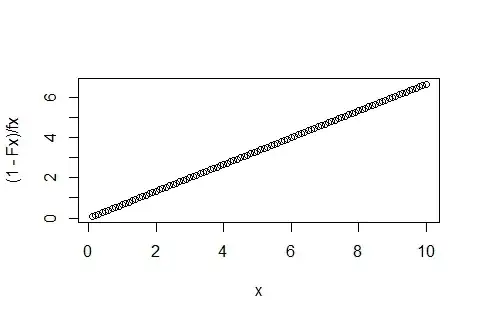I am trying to test this property of pareto distribution: Let f(x) be a pareto distribution
$$ f(x)=\alpha \frac{x_m^\alpha}{x^{\alpha+1}} $$
so we have the cdf that is
$$ CDF(x)=\int_{x_m}^{x}\alpha \frac{t_m^\alpha}{t^{\alpha+1}}dt=1-\frac{x_m^\alpha}{x^\alpha} $$
then the probability that $x>x_0$ is
$$ P(x>x_0)=1-CDF(x)=\frac{x_m^\alpha}{x^\alpha} $$
and so we have
$$ \frac{P(x>x_0)}{f(x)}=\frac{x}{\alpha} $$
Now i am trying to test it with R.
library(PtProcess)
dd<-rpareto(10000,1.5,0.01)
cdf<-ecdf(dd)
df<-density(dd)
ff<-(1-cdf(df$x))/df$y
If i plot ff
plot(df$x,ff)
I do not obtain the correct straight line. I guess that this is due at the way density() and ecdf() works. I need this form of the test (an a posteriori evaluation of fd and cdf) in order to perform the same test on a sample of data of unknown orgin. I guess that i need a way to binning the ecdf() function in the same way as hist() is the binning version of density.
So my question is:
- Does there exist an equivalent binned function of ecdf() as hist() is the binned function of density()?
- or can I simulate ecdf() with hist()?
